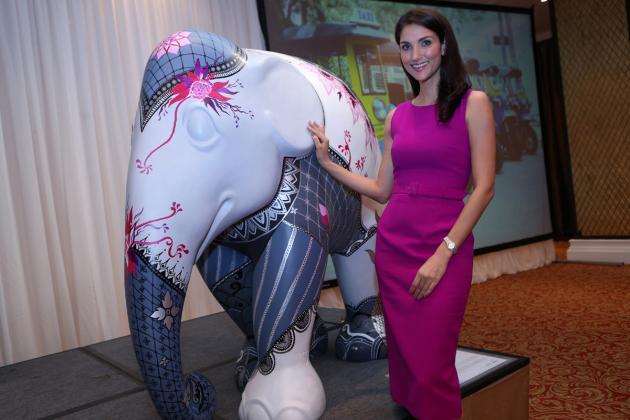How to paint an elephant

Fibreglass models charmingly decorated by celebrities are the stars of a charity event for our pinched pachyderms
Upcountry elephants’ banana sales on Bangkok streets are likely to slump in December as sumptuously decorated fibreglass elephants muscle into the scene – life-size models from an internationally acclaimed exhibition called “The Elephant Parade”.
There will be “royal” elephants in silver and gold headdresses, a beast wearing a sarong and an elephant-headed tuk tuk – 88 sculptures in all. The show’s been to 20 cities around the world since 2007 but is only now getting to elephant-giddy Thailand, where the idea actually originated.
“During our first trip in Thailand in 2006, my dad and I visited the Friends of the Asian Elephant hospital in Lampang and saw Mosha, the baby elephant that lost a leg stepping on a landmine when she was seven months old,” says Mike Spits, a Dutchman who with father Marc put the parade together. “Mosha was the first elephant ever to receive a prosthetic limb.”
The following year they founded the Elephant Parade as an organisation to raise money for other injured pachyderm patients at the hospital, tapping the talents of artists in northern Thailand. “The Elephant Parade” show had its debut in Rotterdam, their hometown, in 2007, and the organisation now has the grander ambition of saving Asian elephants from extinction.
The show’s been to London, Milan, Copenhagen, Hong Kong and cities in California, among other places, and everywhere it goes, local artists and celebrities are invited to decorate several 1.5-metre-tall fibreglass models that are auctioned off to raise funds.
A likeness of Mosha is invariably the star of the affair. In Bangkok she’ll be wearing a prosthetic leg with a classical Thai theme – lacquer adorned with gold leaf.
Sponsoring the Bangkok event are Minor International, whose chief executive, William Heinecke, founded the Golden Triangle Asian Elephant Foundation in 2006, and its affiliate, Anantara Hotels, Resorts & Spas. The money raised will go to the foundation while at the same time commemorating His Majesty the King’s 88th birthday.
More than 20 Thai artists, designers, entertainment stars and other celebrities are participating. Screen stars Nirut Sirichanya and Japanom “Tony Jaa” Yeerum have come up with elephant ideas, as have musicians Pod Moderndog, Pee Arak and Kong Saharat of Nuvo, fashion designers Milin, Moo Asava, Senada, Tutti, Jitsing Somboon and Hiroka Limviphuvadh, artists ML Jirathorn Jiraprawat, Maitree Siriboon, Wisut Ponnimit and Pongsuang “Note” Kunprasop, and architect Duangrit Bunnag.
Supermodel Sirinya “Cindy” Bishop spent six months painting her version, girdling it in a chic sarong. “The elephant is our country’s national symbol,” she notes, “but somehow this once-revered and noble creature is now forced to beg for food on the busy and dangerous streets of the capital.
“I truly hope that this magnificent colourful pachyderm parade will raise awareness and inspire us all to take more concrete steps to ensure their survival and wellbeing.”
Cindy says she’s always loved traditional Asian fabrics and the stories told in the patterns of women’s sarongs. “That’s what I used as the basis for my elephant design, with monotones and graphic designs to symbolise the borders – both natural and man-made – that challenge elephants, and free-form flowers to represent their lively spirit.”
Cindy’s named her elephant Serina, a play on her own name that incorporates the Thai word seri, meaning “freedom”.
Martial-arts hero Tony Jaa became an action-film star with the “Ong-bak” movies, in which his beloved elephant is snatched by poachers, so he’s a natural for this “rescue” project, and duly obliged with a model in pastel pink sporting a forehead cap with a Thai motif. It’s called “Jaa Chok Dee” (“Lucky Jaa”).
“I’ve spent a lot of quality time with elephants,” he says. “I grew up in a family of mahouts and started my movie career with an elephant as my co-star. So I want to thank all the people and organisations who spend their time and resources ensuring the safety of these intelligent creatures.”
Also among the Bangkok herd will be a “hi-so elephant” named “Plai Maha Mongkol” – partly covered in gold. Chulalongkorn University design instructor Santi Khunprasert had the support of local gold shop Prima Art in decorating a blue elephant sitting on its hind legs with its trunk curled around a gilded ball.
Another ball comes into play in the entry from Chang Beer, a grey elephant in a green coat bearing the signatures of national football players Therathorn Boonmathan, Kirkrit Taweekarn, Theerasilp Dangda, Sarat Yuyen, Narubodin Weerawattananodom and Sintawee Hatairattanakul.
“The Elephant Parade” will be on view at Siam Paragon for the first three weeks of December and then move to the Asiatique mall on the Chao Phraya River for Christmas and New Year. In mid-January it moves outdoors to graze in Lumpini Park.
The auction will take place in February at a gala dinner at the Anantara Siam Bangkok, with proceeds going to the Golden Triangle Asian Elephant Foundation. The foundation will divide the money among sustainable programmes that benefit elephants, such as the Wildlife Alliance, Freeland, WildAid, Think Elephants and the Thai Elephant Therapy Project.
TOO CUTE TO MISS
< “The Elephant Parade” will be at Siam Paragon’s Parc Paragon from December 1 to 18, Asiatique from December 20 to January 11 and Lumpini Park from January 15 to 29.
RELATED





